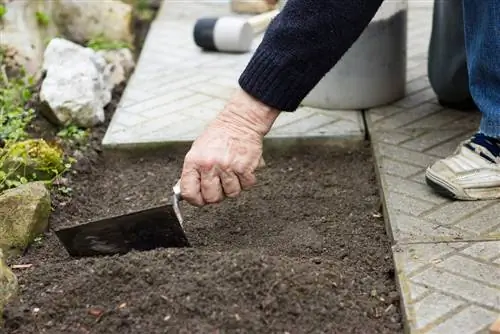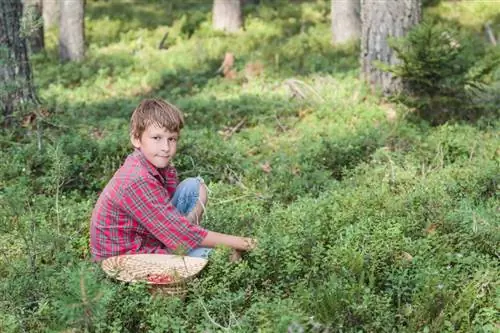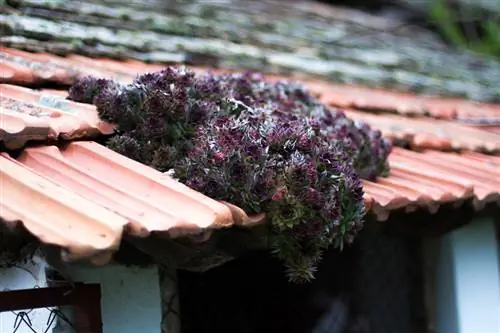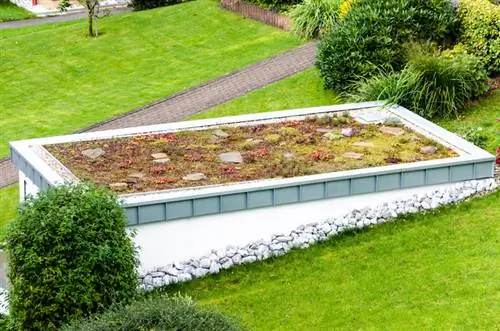- Author admin [email protected].
- Public 2023-12-16 16:46.
- Last modified 2025-06-01 06:02.
Laying slabs made of concrete or natural stone in the garden is not an easy and, above all, difficult undertaking. While concrete slabs can be installed quite easily, laying natural stone slabs is much more demanding. Not only is the material often much more expensive, but the processing and professional assembly also require a certain degree of sensitivity and knowledge of the material.

How do you lay garden tiles correctly?
To lay garden tiles, you need a suitable substructure made of gravel or frost protection gravel and sand or grit. Make sure there is a sufficient slope for drainage and lay concrete or natural stone slabs with joints. Grout concrete slabs with quartz sand and natural stone slabs with natural stone adhesive.
Slab coverings always require a slope
Slab coverings always require a slope so that excess surface water can drain away. If laid on sand and gravel with permeable joints, a two percent gradient is sufficient, whereas sealed surfaces require a gradient of a good three percent. Lay the slope so that it runs away from buildings and drains into a planting or lawn area. This not only saves you complex drainage systems, but also ensures the necessary irrigation of the vegetable garden.
Create a suitable substructure for garden slabs
The larger the individual panels are, the more securely they must rest and the more important it is when building the area to have a substructure that is frost-proof and absolutely solid and level. For fragile natural stone slabs, it is even recommended to build a concrete foundation. This guarantees that the (always frost-proof!) panels will not break over the course of many years. There are two different ways to create a substructure: water-permeable and water-impermeable. The latter is a concrete foundation that rests on compacted gravel or frost protection gravel.
Building a water-permeable foundation:
- Dig the area to be covered at least 50 (better still 60 or more) centimeters deep.
- This is followed by an approx. 30 centimeter thick layer of gravel or anti-freeze gravel.
- This is compacted with a vibrating plate.
- Then add at least another ten centimeters of sand or grit.
- This layer is also thoroughly shaken up.
With the waterproof substructure, fill in a layer of concrete instead of sand or grit. The panels are glued to the still wet concrete, which is why you should not apply the layer all at once, but in several steps. Otherwise you would have to hurry up with applying, aligning and gluing the panels.
Laying concrete slabs - this is how it works
For concrete slabs, a water-permeable substructure is usually sufficient, so that the slabs are laid on sand or gravel. Always measure the panels with a straightedge and, if necessary, align them using a trowel or small shovel. Finally, tap them into place with a rubber mallet. If you are laying on sand, you should moisten it slightly before laying so that it can no longer settle after laying. Depending on the type of panel, leave gaps of four to seven millimeters and only then connect the next panel.
Grouting concrete slabs
Now sweep fine quartz sand into the joints, where it wedges and provides strength. Leave excess sand on the surface for a few days and then use a broom to sweep it into the joints where the sand has settled a little in the meantime.
Laying natural stone slabs - you should pay particular attention to this
You generally lay natural stone slabs (such as granite, sandstone or bas alt) as described for the concrete slabs, but here you do not grout with quartz sand, but with a special adhesive for natural stone slabs. You can make final corrections using a rubber mallet. After laying, clean the panels with a wet sponge. Never place panels close together without a joint so that they have room to move in the event of strong temperature fluctuations. Always work from the inside out and try not to leave any large gaps. However, larger gaps can also be easily filled with pebbles, small stone or soil in which you can plant moss or other small ground cover.
Tip
So that the panels do not tip over at the edges, the substructure should be placed a little beyond the surface of the panel. You can then fill this with soil for a lawn or a planting area.






